Airfix 1/48 Vampire F.3
The Airplane:
Unlike the Gloster Meteor - which was always intended to be an operational fighter - the deHavilland Vampire began as an experimental aircraft, originally developed to specification E6/41, to test the deHavilland Halford H.1 jet engine. Design of what the company named the DH-100 began at the deHavilland factory at Hatfield in mid-1942, some two years after the Meteor began development. Known in the company as the “Spidercrab,” the aircraft utilized deHavilland's extensive experience in using molded plywood for aircraft construction, and was the last composite wood/metal construction high performance military aircraft. To reduce thrust loss for the single - later known as the Goblin - the design centered around an egg-shaped aluminum- surfaced fuselage (which had a wooden basic structure) with the rear control surfaces on twin booms to either side of the fuselage; this allowed for a short exhaust pipe which reduced thrust loss. While the design looks strange today, at least two contemporary German jet fighter projects used a similar layout.
The first prototype, LZ548/G, was flown by Geoffrey deHavilland on September 20, 1943, only six months later than the Meteor. Performance was good enough that the RAF supported further development as a fighter to supplement the Meteor. The production Mk I, by this time known as the “Vampire,” did not fly until April, 1945. Almost all Vampire F Mk. Is were built by English Electric, due to the commitment of deHavilland for production of the Mosquito series.
The first of 268 Vampire F Mk.1 fighters was taken on charge by 247 Squadron in March 1946. Improvements were introduced on the line as production progressed, with the Goblin 2 of 3,100 lb thrust introduced along with auxiliary under wing fuel tanks with the 40th airplane and a pressurized cockpit and bubble canopy from the 51st. The centrifugal engine was thirsty, and the early Vampires suffered from having a range of only 730 miles.
The range problem was addressed in the Vampire F Mk.3, built to specification F.3/47, which carried additional fuel in large underwing drop tanks that extended the range to 1,145 miles. The tanks caused stability problems, which were solved by lowering the horizontal stabilizer, widening its chord, and changing the shape of the fin and rudder. The prototype, TG275, first flew on November 4, 1945 and the F Mk.3 entered service with 54 Squadron in April 1948. With the introduction of the F.B.5 fighter-bomber, which became the most numerous of the series with 485 produced, the F.3 was progressively transferred to second-line units and became the first jet issued to the reserve squadrons of the Royal Auxiliary Air Force.
The Vampire was the first British jet to fly faster than 500 mph, and an F.3 set an altitude record of 59,055 feet. An F.3 also became the first jet to fly the Atlantic. The Vampire was the most maneuverable of the first generation jets, with light, responsive controls, though tight banking at low speed and low altitude could be dangerous, while sudden throttle movement could cause a flame-out.
The Vampire was the first jet flown by the Royal Canadian Air Force as well as the Royal Australian Air Force and the Royal New Zealand Air Force. In all its 20 basic versions and over 50 variants, the Vampire served with 30 Air Forces and was produced in France under license. It only left Swiss service at the end of the 1980s. Several privately-owned Vampires have been flown in the United States since the 1960s, with its most famous private owner being actor John Travolta, who has owned and flown his F.3 for the past 40 years.
The Kit:
The Vampire was first produced as a 1/48 kit in the 1990s by Hobbycraft, which released an f.1, F.3, FB.5, T.11 and NF.3. The less said about these terrible kits, which were at best “Vampire-ish,” the better. These were followed in the early 2000s by Classic Airframes, with the F.3/FB.5 first released being sadly inaccurate, though later releases of the kit were corrected in shape and outline details; a two-seat Vampire trainer and night fighter kits were also released; these are still the best kits of these variants released in 1/48 injected plastic. This was followed in 2011 by Alley Cat Multi-Media Kits, a brand of A2Zee Models, one of three Vampire kits the company announced it would produce, the Vampire F.Mk 1, and the T.11 trainer being the others; these were not released when the company failed and was bought by another owner.
This release from Airfix earlier this year is by far the best injection-plastic Vampire fighter, with regard to shape accuracy and buildability. Unfortunately, this is one of the Airfix kits produced in India. Fortunately, it isn't short-shot, as was the first Spitfire XIVE kits. It is however continuing proof that someone needs to go to India and teach them how to produce injection-molded plastic kits. The particular kit I have was pulled from the mold too quickly, with the result that the upper and lower fuselage/wing parts were flawed and would not fit as they were when taken off the sprue trees. Luckly, the plastic is soft and it was possible to bend the parts to a closer approximation of the shape they should have been, with better fit. However, the fit of these two crucial parts was more reminiscent of an early MPM limited-run kit than a mainstream injection kit which this purports to be. Also, the clear parts were pulled too soon, and as a result they re distorted so severely one cannot see anything through them clearly.
Interestingly, the different wingtips for the F.B.5 and F.B.9, and the different right-side air intake with the englarged fairing where the air conditioning unit was installed in the F.B.9, are included, which allows the modeler to do any version, as was the case with the Hurricane I kit.
Decals are from Cartograf and are excellent. Three aircraft, one from 601 Squadron R.Aux.AF in 1952, a Norwegian Air force Vampiare and an RCAF F.3, are provided. The British and Norwegian aircraft are done from excellently-restored museum specimens, and it is likely the same is true of the FCAF airplane. All are for Vampires in High Speed Silver finish, though the RCAF airplane has red outer wings and nose for Arctic operation.
It should be noted that Xtradecal has two very good 1/48 sheets for single-seat Vampires, covering all three versions, from different national operators and with differing paint schemes.
One thing of note is the price. This is a kit that, five years ago, would have retailed for US$24.00, upped to $32 two years ago. Today's price is $44.95; all that increase is due to supply and production problems from the disruptions since 2020.
Construction:
One cannot go wrong following the kit instruction booklet. These are some of the best instructions out there, and they aren't “someone's opinion.” They're easy to follow.
I began with some industrial-strength squeezing and bending of the two parts that combine the upper and lower fuselage and wings, with particular attention to the forward fuselage. Once I could test-fit these to a close fit approximation, I proceeded with construction.
I assembled the cockpit and attached it to the lower fuselage half, along with the nose gear well, then painted the cockpit. It's overall black, while the seat is brown, being made of the same material as the Spitfire seat was. I applied the decals, and some Eduard late RAF seatbelts.
I knew the model would need more weight than the instructions called for, and that nose part wasn't big enough for what it would take. Fortunately, I was able to glue in the fishweights behind the cockpit, in the area between the intake trunking. I balanced the model on my finger tips at the point where the main gear would attach, and kept adding weight till it tipped over easily, ensuring a nose sit.
I then assembled and attached the tail booms and assembled and attached the horizontal stabilizer. Mating the upper and lower fuselage/wing parts required a lot of rubber bands, gluing a bit at a time, then applying CA glue to the horrid joint in the forward fuselage and sanding it smooth, then applying some Mr. Surfacer and sanding that smooth. With all that, the seam disappeared.
I then attached the lowered flaps and landing gear, since everything would be painted silver.
Painting:
I misted on Tamiya X-18 “Semi-Gloss Black” for a primer coat, then misted on Vallejo “Dull Aluminum” overall. When that was all dry, I applied some Micro “Satin” clear varnish overall to get the “painted” look.
Decals:
I chose to do the 601 Squadron airplane. The decals went on without problem and set up perfectly with Micro Sol.
Final assembly and finish:
I glued the wheels to the landing gear, attached the gear doors, and unmasked the canopy.
Overall:
As anyone who has read my reviews of the Classic Airframes Vampire knows, I was underwhelmed with that kit, and only ever built a Hobbycraft Vampire halfway before dumping it in the round file. This kit from Airfix solves all the problems of the Classic Airframes release. Overall quality is excellent, and the simple design assures a “weekend project.” For those who like the Vampire, this is a sweet kit, despite the production quality control problems in India
It's taken four years for Airfix to finally release the Spitfire F.R. XVIII that was lurking in the Spitfire F.R. XIVE kit, while the tropical Hurricane I and the Sea Hurricane came out within a year of the Hurricane I kit's release. Those difference are likely from sales. I have no idea when the F.B.5 and F.B.9 Vampires will be released, but everything is in there now, and as mentioned, Xtradecal has the markings one would want.
This kit allows you to finally turn the Hobbycrap kits into the doorstops they have so desperately wanted to be from the beginning. The Classic Air Frames kits are now selling at kit collector prices, and the Alley Cat resin kit is long out of production. For those who like early jets, this is the kit for you. It really is a weekender, and the result is nice.
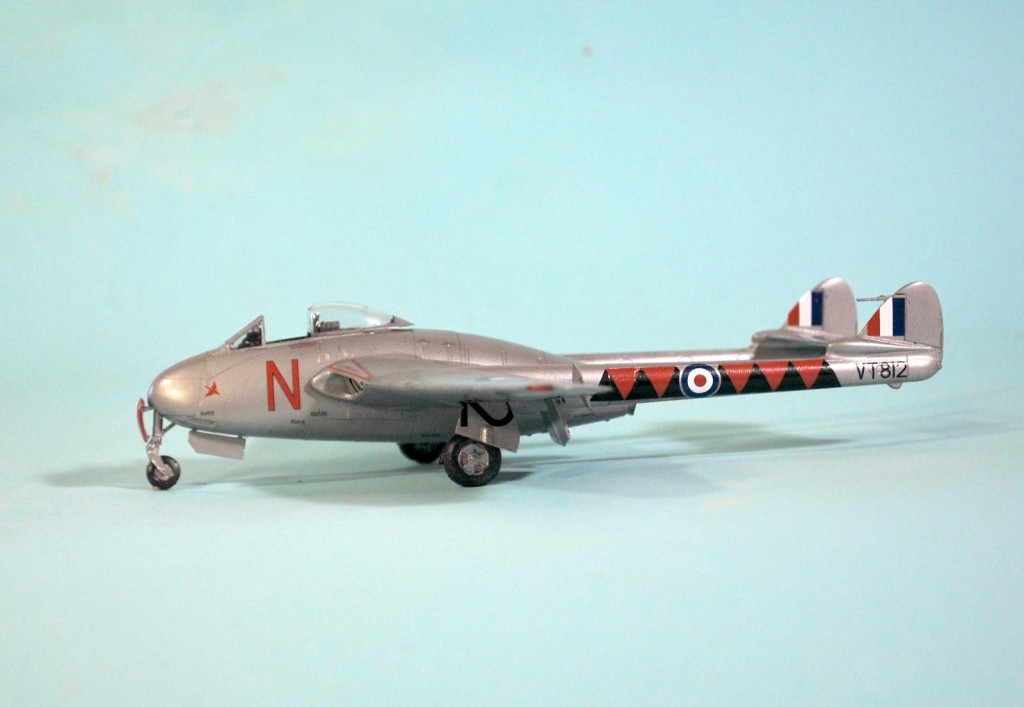
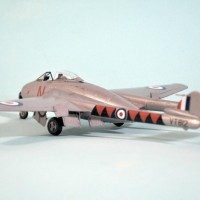
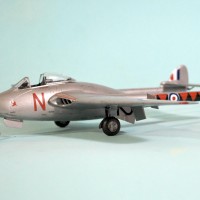
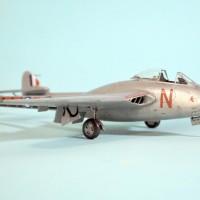
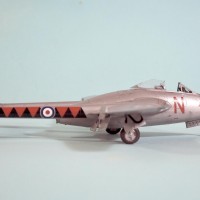
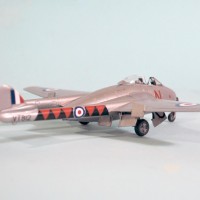
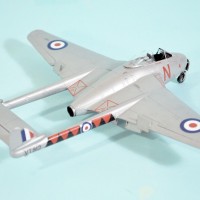
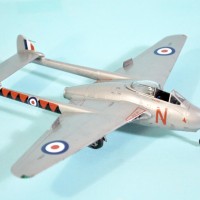
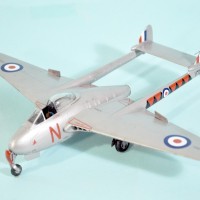
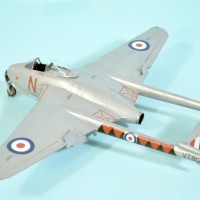
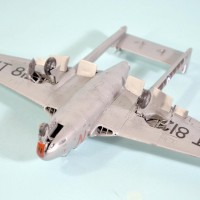
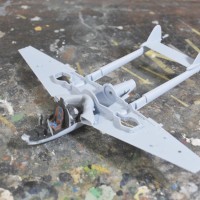
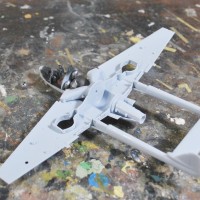
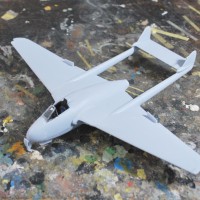
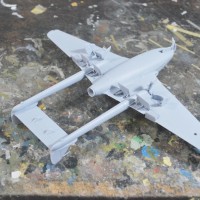
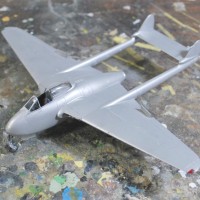
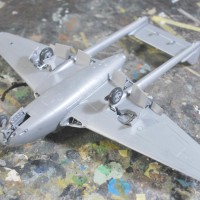
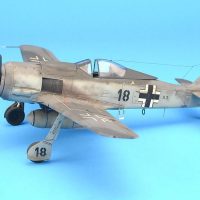

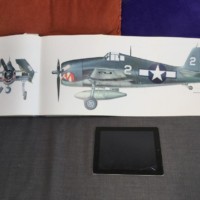

Nice work and interesting history Tom. I've thought of doing a "what if" Republic of Texas Vampire for several years. This would seem to be the one to choose. Thanks for posting this @tcinla! ?
Nice result, Tom. I was lucky and didn’t have the warpage issues yours had. It seemed to me that the cockpit side consoles interfered with the fuselage fit and I trimmed them accordingly.
Excellent looking Vampire, Tom. The Vallejo paint looks great. Another winner from Airfix.
I'm amazing just how 'compact' the Vampire is in real life, and just how much wood was used.
Ontario's Waterloo Warbirds show a photo of their T55 and looks like everything forward of the intakes utilizes wood.
Great looking Vampire, Tom @tcinla
Even while not being a jet modeller, this early age jet might find its way to the shelf after your building experience on this kit.
Excellent model and a great writeup, Tom!
Sweet little build, Tom. Well done!
Very beautiful build, great metallic colors. I love the kit, Airfix really doing the job again.
Good rescue. Three things I took from this-A wooden jet? Ouch. Vallejo metallics must be given a trial. And 44 bucks? Wow.
As the guy said in the checkout line, "everything goes up except my income."
It does build into a handsome Vamp!
Well done Tom and thank you for the narrative.
As above, nice work!
Not my thing, but you did an excellent job!
Excellent looking Vampire, Tom.
Nice work Tom!
Great looking Vampire!
Once again, Tom, a very nice build and great narrative! With all of your writing and everything else, I just wonder where you find time to produce such beautiful gems...
@trod348 - the models are the solution to "block." Get blocked, spend an hour working on a model (the specific desks are arm's length from each other, return with the solution to what was blocking things. Plus, after all these years of practice, I have shortcuts in both fields of endeavor.
Hi Tom, great build and history on the subject. Vampires also served quite extensively in the South African Air Force as jet trainers. There is a fairly well kept museum exhibit at the Zwartkops Airforce Museum near Pretoria in South Africa... was in flying condition until around the early 2000's if my memory serves me correctly.
Hello! Dull Aluminium from Vallejo match High Speed silver?